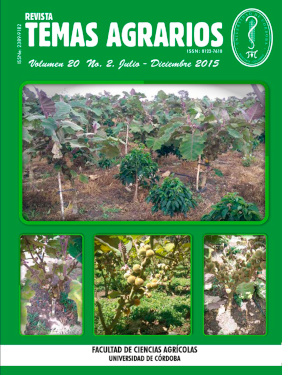Effect of the microbial activity on nitrification in soils cultivated with Brachiaria humidicola (Rendle) Schweicerdt in Cerete, Cordoba
Efecto de la actividad microbiana sobre la nitrifiación en suelos cultivados con Brachiaria humidicola (Rendle) Schweicerdt en Cereté, Córdoba
How to Cite
Grandett, L., Reza, S., Jaraba Navas, J. D. D., & Pardo, Y. (2015). Effect of the microbial activity on nitrification in soils cultivated with Brachiaria humidicola (Rendle) Schweicerdt in Cerete, Cordoba. Sour Topics, 20(2), 9-18. https://doi.org/10.21897/rta.v20i2.754
Dimensions
license

This work is licensed under a Creative Commons Attribution-NonCommercial 4.0 International License.
Show authors biography
Article visits 879 | PDF visits
Downloads
Download data is not yet available.
- Bronson Bronson, K. 1994. Suppression of methane oxidation in aerobic soil by nitrifiation inhibitors. Biology and Fertility Soils 17. pp. 263-268.
- Canchila, R., Soca, M., Wencomo, H., Ojeda, F., Mateus, H., Romero, E., Argüello, G., Ruiz, R. y Canchila, N. 2011. Comportamiento agronómico de siete accesiones de Brachiaria humidicola durante la fase de establecimiento. Pastos y Forrajes 34(2):155-166
- Chaves-Bedoya, G., Ortiz-Moreno, M. y OrtizRojas, L. 2013. Efecto de la aplicación de agroquímicos en un cultivo de arroz sobre los microorganismos del suelo. Acta Agron. vol.62, n.1, pp. 66-72. ISSN
- -2812.
- Cerón, L. y Aristizábal, A. 2012. Dinámica del ciclo del nitrógeno y fósforo en suelos. Rev Col de Biotecnol vol.14 (1) pp. 285- 295
- Dinnes, L., Karlen, L., Jaynes, D., Kasper, C., Hatfild, L., Colvin, S y Cambardella, A. 2002. Nitrogen management strategies to reduce nitrate leaching in tile drained. Midwestwn soil. Agron. J. 94: 153-171.
- Elda B. y R. Perotti. 2015. El impacto de la hidroquinona usada como un modelo de efector redox sobre la desnitrifiación potencial, la actividad microbiana y las condiciones redox de un suelo cultivable. Rev Argent Microbiol. 47(3):212-218
- Franklin, R. y Mills, A. 2003. Multi-scale variation in spatial heterogeneity for microbial community structure in an eastern Virginia-agricultural fild. FEMS Microb. Ecol. 44: 335-346.
- Grageda, O., Vermoesen, A., Cleemput, O. y Peña, J. 2000. Efecto del tipo de suelo, humedad y fuente de nitrógeno en las emisiones de N 2 y N 2O. Rev. Terra. 18(1). pp. 1-10.
- ICA, 1992. Instituto Colombiano Agropecuario. Fertilización de Diversos Cultivos. Quinta Aproximación. Manual de Asistencia Técnica No. 25. Bogotá. 64p.
- IGAC. 1990. Instituto Geográfio Agustín Codazzi. Métodos analíticos del laboratorio de suelos. Bogotá. 5a edición. 664p.
- Knowles, R. 1982. Denitrifiation. Microbiol. Rev. 46: 43-70.
- Lata, J., Durand, J., Lensi, R. y Abbadoe, L. 2000. Stable coexistence contrasted nitrifiation statuses in a wet tropical savanna system, Fun, Ecol, 13: 762-763.
- Lodhi, M. 1982. Additional evidence of inhibition of nitrifers and possible cycling og inhibitors produced by selected plants in a climax community. Bull Torrey Bot Club 109: 199-204.
- Montaño, N. y Sánchez-Yañez, J. 2014. Nitrifiación en suelos tropicales, asunto de competencia microbiana: un modelo basado en la teoría de Lotka-Volterra. Ecosistemas 23(3): 98-104. Doi.: 10.7818/ECOS.2014.23-3.13.
- Negroni, M. 2009. Microbiologia estomatológica, fundamentos y guía práctica. Crecimiento, nutrición y metabolismo bacterianos. 2a ed. Buenos Grandett et al. - Nitrifiación en campos de Brachiaria humidicola Aire, Argentina. SNB: 978-950-06-1584- 6. 656p.
- Raun, R. y Johnson, G. 1999. Improving nitrogen use effiiency for cereal production. Agron.J. 91: 357-363.
- Saad, A. y Conrad, R. 1993. Temperature dependence of nitrifiation, denitrifiation and turnover of nitric oxide in different soils. Biol. Fert. Soils, 15: 21-27.
- Sanaa, M. 1993. Dynamique et bilan del azote mineral dansquelques sols calcaires in tunisie. Thése Docteur en Sciences Agronomiques. Gent, Belgique.
- Sextone, A., Revsbech, N., Parkin,T. y Tiedje, J.. 1985. Direct measurement of oxygen profies and denitrifiación rates in soil aggregates. Soil Sci. Soc. Am. J., 49: 645- 651.
- Sommer, K., Mertz, M. y Rossig, K. 1976. Stickstoff zu weizen mit ammonium nitrifiiden. Mitteilung 2: proteingehalte, proteinfraktionen und backfahigkeit. L Landwirtschaftliche. Forschung 29: 161-169.
- Sousa, M. y Lobato, E. 2004. Adubação com nitrogênio. In ‘Cerrado: correção do solo e adubação. Brasília, Embrapa Informação Tecnológica, 2004’. Eds DMG Sousa, E Lobato pp. 129-144. www.cpac.
- embrapa.br/ downlo ad/1729/t. [21 de abril del 2015].
- Subbarao, G., Ishikawa, T., Ito, O., Nakahara, K., Wang, H. y Berry, W. 2006a. A bioluminescence assay to detect nitrifiation inhibitors released from plant roots a case study with Brachiaria humidicola. Plant Soil. http://www. springerlink.com/content/r435654g2r 514044. [Noviembre de 2008].
- Subbarao, G., Rondón, M., Rao, I., Ishikawa, T., Ito, O., Hurtado, M., Amezquita, E., Barrios, E. y Lascano, C. 2006b. Field validation of the phenomenon of nitrifiation by Brachiaria humidicola and
- other tropical grasses. In: Suenaga, K., Kudo, H., and Oshio S. (eds) Comprehesive studies on the development of sustainable soybean production technology in south America. JIRCAS. Working Report, 51: 107-112.
- Subbarao, G., Nakahara, K., Hurtado, M.,Ono, H., Moreta, D., Salcedo, A., Yoshihashi, A., Ishikawa, T., Ishitani, M., Ohnishi, M., Yoshida, M., Rondón. M., Rao, I., Lascano, C., Berry, W. y Ito, O. 2009.
- Evidence for biological nitrifiation inhibition in Brachiaria pastures. Proc Natl Acad Sci USA. 106:17302-17307.
- Trevors, J. 1998. Bacterial biodiversity in soil with an emphasis on chemicallycontaminated soil. Water air soil pollut. 101:45-67.
- Withe, C. 1991. The role of monoterpenes in soil nitrogen cycling in ponderosa pine. Biogeochemistry. 12:43-68.




















